Norway, IA Map & Demographics
Norway Map
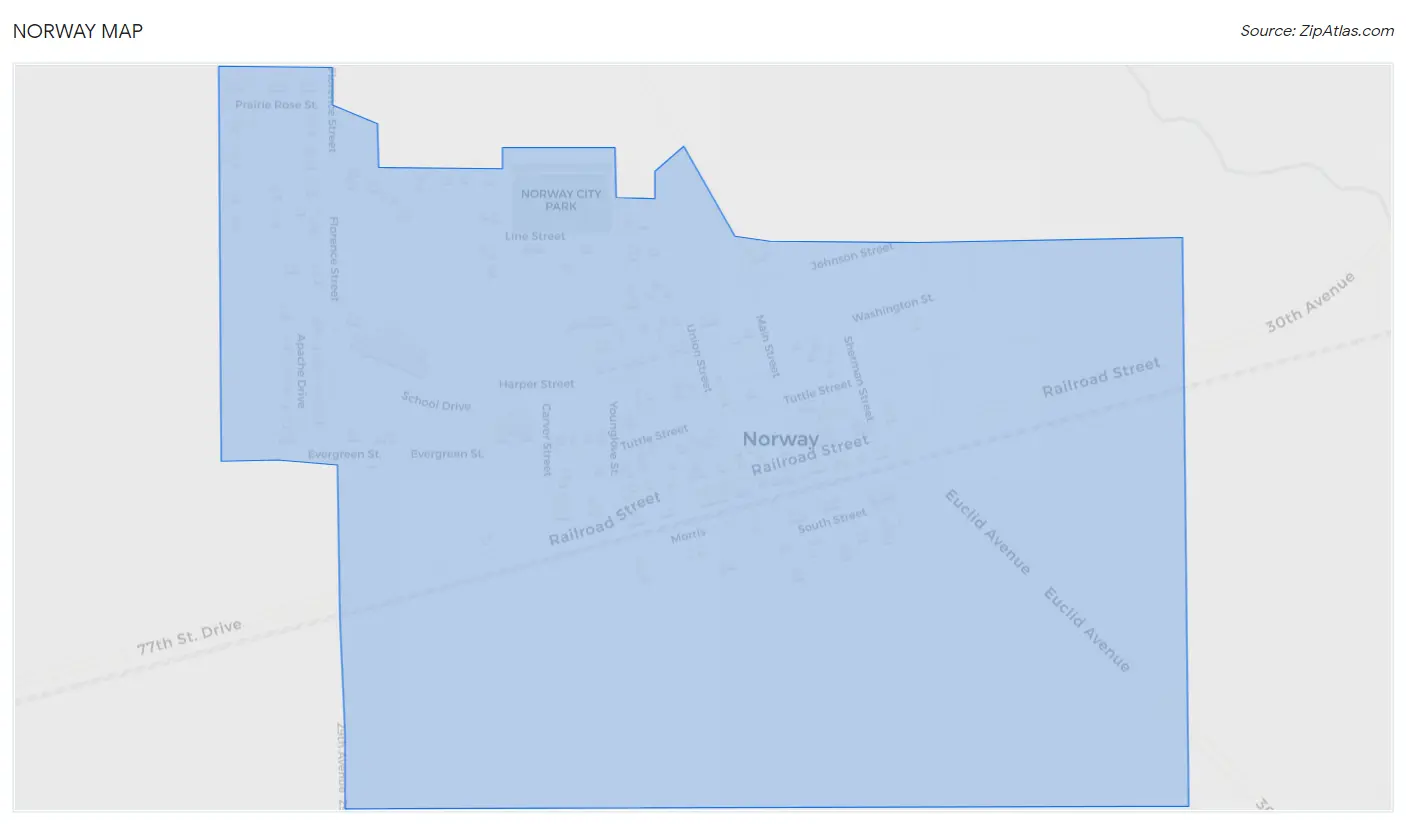
Norway Overview
$40,856
PER CAPITA INCOME
$101,000
AVG FAMILY INCOME
$90,000
AVG HOUSEHOLD INCOME
37.5%
WAGE / INCOME GAP [ % ]
62.5¢/ $1
WAGE / INCOME GAP [ $ ]
0.31
INEQUALITY / GINI INDEX
516
TOTAL POPULATION
292
MALE POPULATION
224
FEMALE POPULATION
130.36
MALES / 100 FEMALES
76.71
FEMALES / 100 MALES
48.3
MEDIAN AGE
3.1
AVG FAMILY SIZE
2.4
AVG HOUSEHOLD SIZE
331
LABOR FORCE [ PEOPLE ]
74.0%
PERCENT IN LABOR FORCE
0.6%
UNEMPLOYMENT RATE
Norway Zip Codes
Norway Area Codes
Income in Norway
Income Overview in Norway
Per Capita Income in Norway is $40,856, while median incomes of families and households are $101,000 and $90,000 respectively.
| Characteristic | Number | Measure |
| Per Capita Income | 516 | $40,856 |
| Median Family Income | 136 | $101,000 |
| Mean Family Income | 136 | $103,128 |
| Median Household Income | 218 | $90,000 |
| Mean Household Income | 218 | $91,215 |
| Income Deficit | 136 | $0 |
| Wage / Income Gap (%) | 516 | 37.52% |
| Wage / Income Gap ($) | 516 | 62.48¢ per $1 |
| Gini / Inequality Index | 516 | 0.31 |
Earnings by Sex in Norway
Average Earnings in Norway are $43,250, $53,214 for men and $33,250 for women, a difference of 37.5%.

| Sex | Number | Average Earnings |
| Male | 194 (56.7%) | $53,214 |
| Female | 148 (43.3%) | $33,250 |
| Total | 342 (100.0%) | $43,250 |
Earnings by Sex by Income Bracket in Norway
The most common earnings brackets in Norway are $55,000 to $64,999 for men (28 | 14.4%) and $17,500 to $19,999 for women (19 | 12.8%).
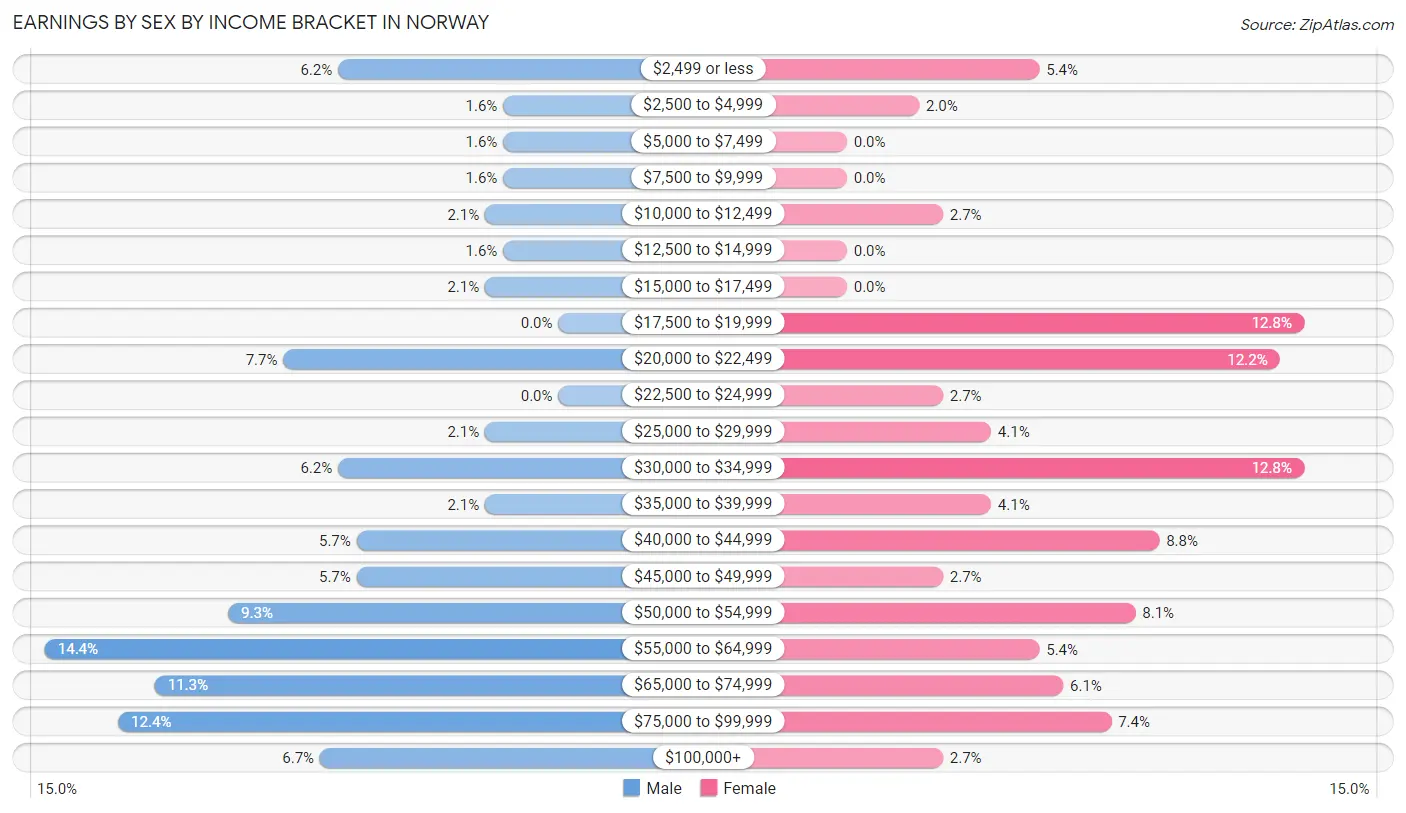
| Income | Male | Female |
| $2,499 or less | 12 (6.2%) | 8 (5.4%) |
| $2,500 to $4,999 | 3 (1.5%) | 3 (2.0%) |
| $5,000 to $7,499 | 3 (1.5%) | 0 (0.0%) |
| $7,500 to $9,999 | 3 (1.5%) | 0 (0.0%) |
| $10,000 to $12,499 | 4 (2.1%) | 4 (2.7%) |
| $12,500 to $14,999 | 3 (1.5%) | 0 (0.0%) |
| $15,000 to $17,499 | 4 (2.1%) | 0 (0.0%) |
| $17,500 to $19,999 | 0 (0.0%) | 19 (12.8%) |
| $20,000 to $22,499 | 15 (7.7%) | 18 (12.2%) |
| $22,500 to $24,999 | 0 (0.0%) | 4 (2.7%) |
| $25,000 to $29,999 | 4 (2.1%) | 6 (4.1%) |
| $30,000 to $34,999 | 12 (6.2%) | 19 (12.8%) |
| $35,000 to $39,999 | 4 (2.1%) | 6 (4.1%) |
| $40,000 to $44,999 | 11 (5.7%) | 13 (8.8%) |
| $45,000 to $49,999 | 11 (5.7%) | 4 (2.7%) |
| $50,000 to $54,999 | 18 (9.3%) | 12 (8.1%) |
| $55,000 to $64,999 | 28 (14.4%) | 8 (5.4%) |
| $65,000 to $74,999 | 22 (11.3%) | 9 (6.1%) |
| $75,000 to $99,999 | 24 (12.4%) | 11 (7.4%) |
| $100,000+ | 13 (6.7%) | 4 (2.7%) |
| Total | 194 (100.0%) | 148 (100.0%) |
Earnings by Sex by Educational Attainment in Norway
Average earnings in Norway are $60,417 for men and $36,250 for women, a difference of 40.0%. Men with an educational attainment of college or associate's degree enjoy the highest average annual earnings of $76,250, while those with high school diploma education earn the least with $53,750. Women with an educational attainment of bachelor's degree earn the most with the average annual earnings of $48,750, while those with college or associate's degree education have the smallest earnings of $26,250.

| Educational Attainment | Male Income | Female Income |
| Less than High School | - | - |
| High School Diploma | $53,750 | $40,000 |
| College or Associate's Degree | $76,250 | $26,250 |
| Bachelor's Degree | $72,917 | $48,750 |
| Graduate Degree | - | - |
| Total | $60,417 | $36,250 |
Family Income in Norway
Family Income Brackets in Norway
According to the Norway family income data, there are 64 families falling into the $100,000 to $149,999 income range, which is the most common income bracket and makes up 47.1% of all families.

| Income Bracket | # Families | % Families |
| Less than $10,000 | 0 | 0.0% |
| $10,000 to $14,999 | 0 | 0.0% |
| $15,000 to $24,999 | 3 | 2.2% |
| $25,000 to $34,999 | 2 | 1.5% |
| $35,000 to $49,999 | 12 | 8.8% |
| $50,000 to $74,999 | 11 | 8.1% |
| $75,000 to $99,999 | 36 | 26.5% |
| $100,000 to $149,999 | 64 | 47.1% |
| $150,000 to $199,999 | 7 | 5.1% |
| $200,000+ | 1 | 0.7% |
Family Income by Famaliy Size in Norway
4-person families (30 | 22.1%) account for the highest median family income in Norway with $117,500 per family, while 2-person families (78 | 57.4%) have the highest median income of $48,125 per family member.

| Income Bracket | # Families | Median Income |
| 2-Person Families | 78 (57.4%) | $96,250 |
| 3-Person Families | 21 (15.4%) | $101,250 |
| 4-Person Families | 30 (22.1%) | $117,500 |
| 5-Person Families | 5 (3.7%) | $0 |
| 6-Person Families | 2 (1.5%) | $0 |
| 7+ Person Families | 0 (0.0%) | $0 |
| Total | 136 (100.0%) | $101,000 |
Family Income by Number of Earners in Norway

| Number of Earners | # Families | Median Income |
| No Earners | 24 (17.6%) | $0 |
| 1 Earner | 25 (18.4%) | $84,688 |
| 2 Earners | 68 (50.0%) | $101,500 |
| 3+ Earners | 19 (14.0%) | $131,563 |
| Total | 136 (100.0%) | $101,000 |
Household Income in Norway
Household Income Brackets in Norway
With 75 households falling in the category, the $100,000 to $149,999 income range is the most frequent in Norway, accounting for 34.4% of all households.

| Income Bracket | # Households | % Households |
| Less than $10,000 | 2 | 0.9% |
| $10,000 to $14,999 | 0 | 0.0% |
| $15,000 to $24,999 | 10 | 4.6% |
| $25,000 to $34,999 | 10 | 4.6% |
| $35,000 to $49,999 | 28 | 12.8% |
| $50,000 to $74,999 | 34 | 15.6% |
| $75,000 to $99,999 | 43 | 19.7% |
| $100,000 to $149,999 | 75 | 34.4% |
| $150,000 to $199,999 | 13 | 6.0% |
| $200,000+ | 3 | 1.4% |
Household Income by Householder Age in Norway
The median household income in Norway is $90,000, with the highest median household income of $97,750 found in the 45 to 64 years age bracket for the primary householder. A total of 113 households (51.8%) fall into this category. Meanwhile, the 15 to 24 years age bracket for the primary householder has the lowest median household income of $0, with 9 households (4.1%) in this group.

| Income Bracket | # Households | Median Income |
| 15 to 24 Years | 9 (4.1%) | $0 |
| 25 to 44 Years | 44 (20.2%) | $96,667 |
| 45 to 64 Years | 113 (51.8%) | $97,750 |
| 65+ Years | 52 (23.8%) | $76,500 |
| Total | 218 (100.0%) | $90,000 |
Poverty in Norway
Income Below Poverty by Sex and Age in Norway
With 1.7% poverty level for males and 3.6% for females among the residents of Norway, 16 and 17 year old males and 75 year old and over females are the most vulnerable to poverty, with 2 males (100.0%) and 2 females (8.7%) in their respective age groups living below the poverty level.
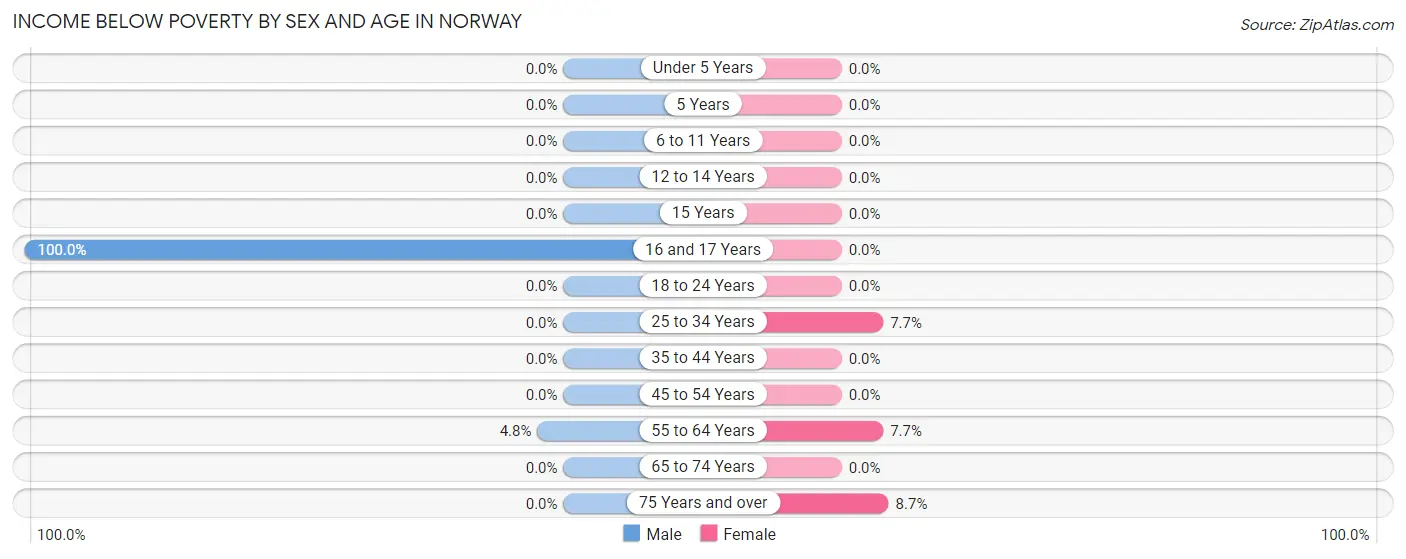
| Age Bracket | Male | Female |
| Under 5 Years | 0 (0.0%) | 0 (0.0%) |
| 5 Years | 0 (0.0%) | 0 (0.0%) |
| 6 to 11 Years | 0 (0.0%) | 0 (0.0%) |
| 12 to 14 Years | 0 (0.0%) | 0 (0.0%) |
| 15 Years | 0 (0.0%) | 0 (0.0%) |
| 16 and 17 Years | 2 (100.0%) | 0 (0.0%) |
| 18 to 24 Years | 0 (0.0%) | 0 (0.0%) |
| 25 to 34 Years | 0 (0.0%) | 3 (7.7%) |
| 35 to 44 Years | 0 (0.0%) | 0 (0.0%) |
| 45 to 54 Years | 0 (0.0%) | 0 (0.0%) |
| 55 to 64 Years | 3 (4.8%) | 3 (7.7%) |
| 65 to 74 Years | 0 (0.0%) | 0 (0.0%) |
| 75 Years and over | 0 (0.0%) | 2 (8.7%) |
| Total | 5 (1.7%) | 8 (3.6%) |
Income Above Poverty by Sex and Age in Norway
According to the poverty statistics in Norway, males aged under 5 years and females aged under 5 years are the age groups that are most secure financially, with 100.0% of males and 100.0% of females in these age groups living above the poverty line.
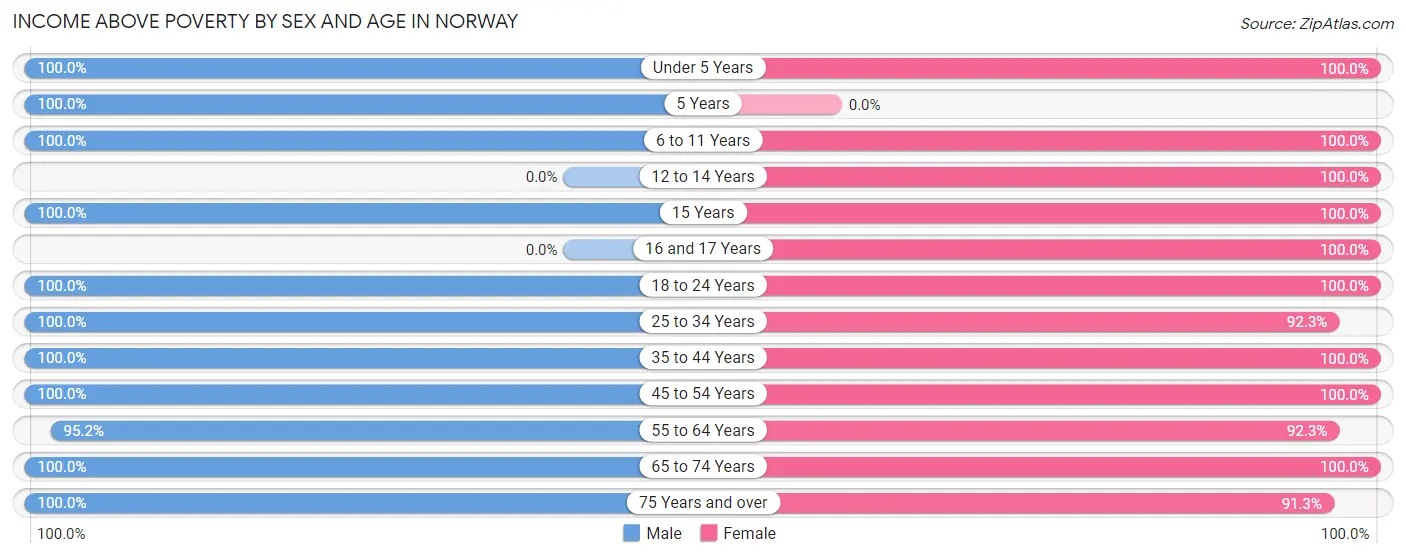
| Age Bracket | Male | Female |
| Under 5 Years | 20 (100.0%) | 23 (100.0%) |
| 5 Years | 2 (100.0%) | 0 (0.0%) |
| 6 to 11 Years | 9 (100.0%) | 5 (100.0%) |
| 12 to 14 Years | 0 (0.0%) | 6 (100.0%) |
| 15 Years | 2 (100.0%) | 2 (100.0%) |
| 16 and 17 Years | 0 (0.0%) | 4 (100.0%) |
| 18 to 24 Years | 47 (100.0%) | 15 (100.0%) |
| 25 to 34 Years | 33 (100.0%) | 36 (92.3%) |
| 35 to 44 Years | 16 (100.0%) | 9 (100.0%) |
| 45 to 54 Years | 38 (100.0%) | 47 (100.0%) |
| 55 to 64 Years | 59 (95.2%) | 36 (92.3%) |
| 65 to 74 Years | 39 (100.0%) | 12 (100.0%) |
| 75 Years and over | 22 (100.0%) | 21 (91.3%) |
| Total | 287 (98.3%) | 216 (96.4%) |
Income Below Poverty Among Married-Couple Families in Norway
The poverty statistics for married-couple families in Norway show that 2.7% or 3 of the total 112 families live below the poverty line. Families with no children have the highest poverty rate of 4.1%, comprising of 3 families. On the other hand, families with 1 or 2 children have the lowest poverty rate of 0.0%, which includes 0 families.

| Children | Above Poverty | Below Poverty |
| No Children | 70 (95.9%) | 3 (4.1%) |
| 1 or 2 Children | 35 (100.0%) | 0 (0.0%) |
| 3 or 4 Children | 4 (100.0%) | 0 (0.0%) |
| 5 or more Children | 0 (0.0%) | 0 (0.0%) |
| Total | 109 (97.3%) | 3 (2.7%) |
Income Below Poverty Among Single-Parent Households in Norway

| Children | Single Father | Single Mother |
| No Children | 0 (0.0%) | 0 (0.0%) |
| 1 or 2 Children | 0 (0.0%) | 0 (0.0%) |
| 3 or 4 Children | 0 (0.0%) | 0 (0.0%) |
| 5 or more Children | 0 (0.0%) | 0 (0.0%) |
| Total | 0 (0.0%) | 0 (0.0%) |
Income Below Poverty Among Married-Couple vs Single-Parent Households in Norway

| Children | Married-Couple Families | Single-Parent Households |
| No Children | 3 (4.1%) | 0 (0.0%) |
| 1 or 2 Children | 0 (0.0%) | 0 (0.0%) |
| 3 or 4 Children | 0 (0.0%) | 0 (0.0%) |
| 5 or more Children | 0 (0.0%) | 0 (0.0%) |
| Total | 3 (2.7%) | 0 (0.0%) |
Race in Norway
The most populous races in Norway are , and White / Caucasian (516 | 100.0%).

| Race | # Population | % Population |
| Asian | 0 | 0.0% |
| Black / African American | 0 | 0.0% |
| Hawaiian / Pacific | 0 | 0.0% |
| Hispanic or Latino | 0 | 0.0% |
| Native / Alaskan | 0 | 0.0% |
| White / Caucasian | 516 | 100.0% |
| Two or more Races | 0 | 0.0% |
| Some other Race | 0 | 0.0% |
| Total | 516 | 100.0% |
Ancestry in Norway
The most populous ancestries reported in Norway are German (264 | 51.2%), Irish (80 | 15.5%), Scottish (43 | 8.3%), Norwegian (33 | 6.4%), and American (31 | 6.0%), together accounting for 87.4% of all Norway residents.
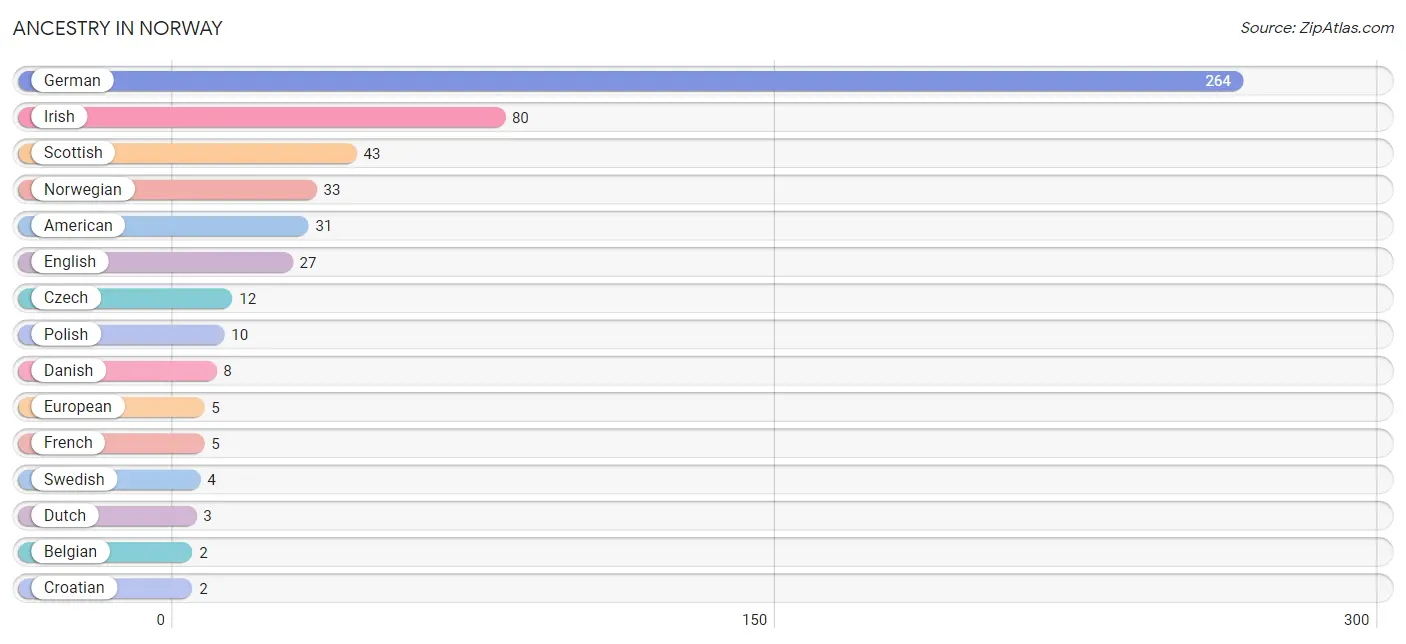
| Ancestry | # Population | % Population |
| American | 31 | 6.0% |
| Belgian | 2 | 0.4% |
| Croatian | 2 | 0.4% |
| Czech | 12 | 2.3% |
| Danish | 8 | 1.5% |
| Dutch | 3 | 0.6% |
| English | 27 | 5.2% |
| European | 5 | 1.0% |
| French | 5 | 1.0% |
| German | 264 | 51.2% |
| Hungarian | 2 | 0.4% |
| Irish | 80 | 15.5% |
| Norwegian | 33 | 6.4% |
| Polish | 10 | 1.9% |
| Scotch-Irish | 2 | 0.4% |
| Scottish | 43 | 8.3% |
| Swedish | 4 | 0.8% | View All 17 Rows |
Immigrants in Norway

| Immigration Origin | # Population | % Population | View All 0 Rows |
Sex and Age in Norway
Sex and Age in Norway
The most populous age groups in Norway are 60 to 64 Years (43 | 14.7%) for men and 45 to 49 Years (30 | 13.4%) for women.
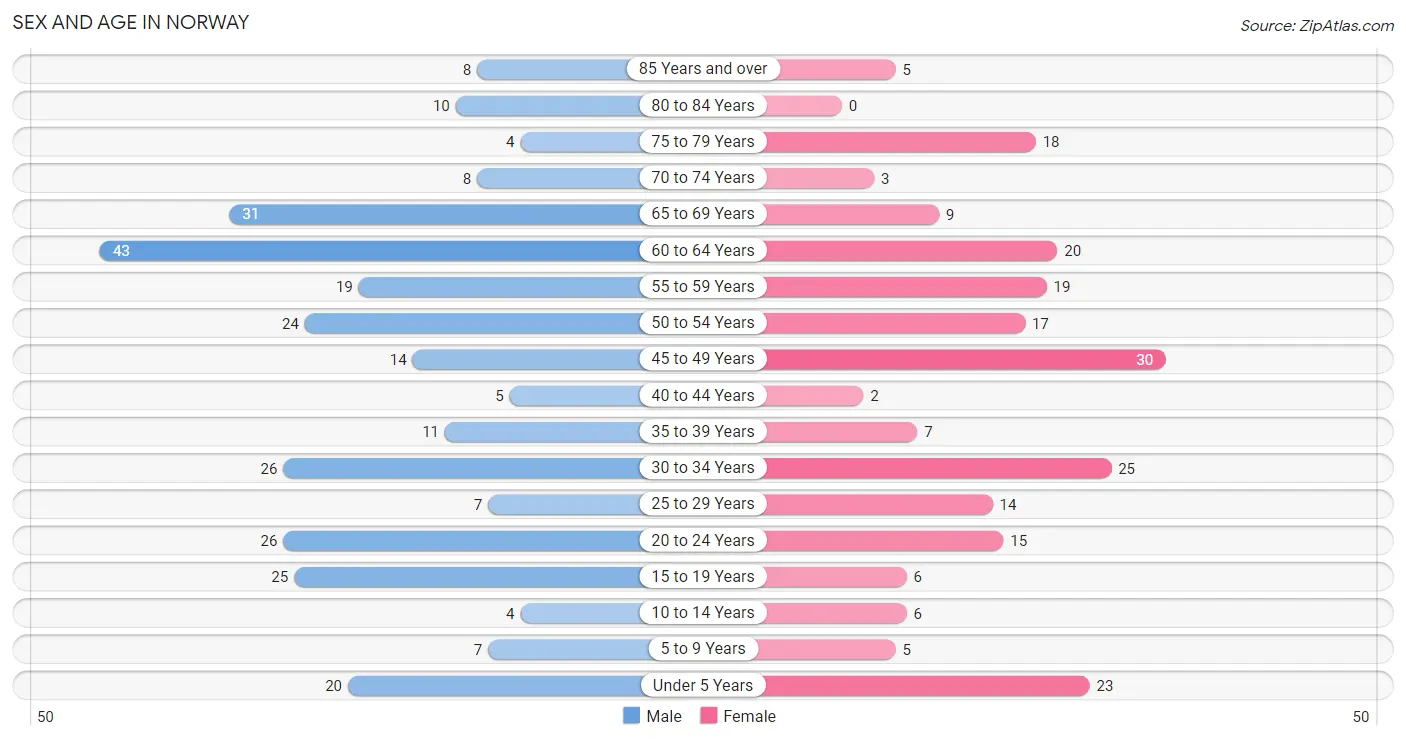
| Age Bracket | Male | Female |
| Under 5 Years | 20 (6.9%) | 23 (10.3%) |
| 5 to 9 Years | 7 (2.4%) | 5 (2.2%) |
| 10 to 14 Years | 4 (1.4%) | 6 (2.7%) |
| 15 to 19 Years | 25 (8.6%) | 6 (2.7%) |
| 20 to 24 Years | 26 (8.9%) | 15 (6.7%) |
| 25 to 29 Years | 7 (2.4%) | 14 (6.2%) |
| 30 to 34 Years | 26 (8.9%) | 25 (11.2%) |
| 35 to 39 Years | 11 (3.8%) | 7 (3.1%) |
| 40 to 44 Years | 5 (1.7%) | 2 (0.9%) |
| 45 to 49 Years | 14 (4.8%) | 30 (13.4%) |
| 50 to 54 Years | 24 (8.2%) | 17 (7.6%) |
| 55 to 59 Years | 19 (6.5%) | 19 (8.5%) |
| 60 to 64 Years | 43 (14.7%) | 20 (8.9%) |
| 65 to 69 Years | 31 (10.6%) | 9 (4.0%) |
| 70 to 74 Years | 8 (2.7%) | 3 (1.3%) |
| 75 to 79 Years | 4 (1.4%) | 18 (8.0%) |
| 80 to 84 Years | 10 (3.4%) | 0 (0.0%) |
| 85 Years and over | 8 (2.7%) | 5 (2.2%) |
| Total | 292 (100.0%) | 224 (100.0%) |
Families and Households in Norway
Median Family Size in Norway
The median family size in Norway is 3.08 persons per family, with single male/father families (6 | 4.4%) accounting for the largest median family size of 3.33 persons per family. On the other hand, single female/mother families (18 | 13.2%) represent the smallest median family size with 2.33 persons per family.

| Family Type | # Families | Family Size |
| Married-Couple | 112 (82.4%) | 3.19 |
| Single Male/Father | 6 (4.4%) | 3.33 |
| Single Female/Mother | 18 (13.2%) | 2.33 |
| Total Families | 136 (100.0%) | 3.08 |
Median Household Size in Norway
The median household size in Norway is 2.37 persons per household, with single male/father households (6 | 2.8%) accounting for the largest median household size of 3.5 persons per household. non-family households (82 | 37.6%) represent the smallest median household size with 1.13 persons per household.

| Household Type | # Households | Household Size |
| Married-Couple | 112 (51.4%) | 3.19 |
| Single Male/Father | 6 (2.8%) | 3.50 |
| Single Female/Mother | 18 (8.3%) | 2.50 |
| Non-family | 82 (37.6%) | 1.13 |
| Total Households | 218 (100.0%) | 2.37 |
Household Size by Marriage Status in Norway
Out of a total of 218 households in Norway, 136 (62.4%) are family households, while 82 (37.6%) are nonfamily households. The most numerous type of family households are 2-person households, comprising 72, and the most common type of nonfamily households are 1-person households, comprising 73.

| Household Size | Family Households | Nonfamily Households |
| 1-Person Households | - | 73 (33.5%) |
| 2-Person Households | 72 (33.0%) | 7 (3.2%) |
| 3-Person Households | 27 (12.4%) | 2 (0.9%) |
| 4-Person Households | 30 (13.8%) | 0 (0.0%) |
| 5-Person Households | 5 (2.3%) | 0 (0.0%) |
| 6-Person Households | 2 (0.9%) | 0 (0.0%) |
| 7+ Person Households | 0 (0.0%) | 0 (0.0%) |
| Total | 136 (62.4%) | 82 (37.6%) |
Female Fertility in Norway
Fertility by Age in Norway
Average fertility rate in Norway is 99.0 births per 1,000 women. Women in the age bracket of 20 to 34 years have the highest fertility rate with 185.0 births per 1,000 women. Women in the age bracket of 20 to 34 years acount for 100.0% of all women with births.

| Age Bracket | Women with Births | Births / 1,000 Women |
| 15 to 19 years | 0 (0.0%) | 0.0 |
| 20 to 34 years | 10 (100.0%) | 185.0 |
| 35 to 50 years | 0 (0.0%) | 0.0 |
| Total | 10 (100.0%) | 99.0 |
Fertility by Age by Marriage Status in Norway

| Age Bracket | Married | Unmarried |
| 15 to 19 years | 0 (0.0%) | 0 (0.0%) |
| 20 to 34 years | 10 (100.0%) | 0 (0.0%) |
| 35 to 50 years | 0 (0.0%) | 0 (0.0%) |
| Total | 10 (100.0%) | 0 (0.0%) |
Fertility by Education in Norway
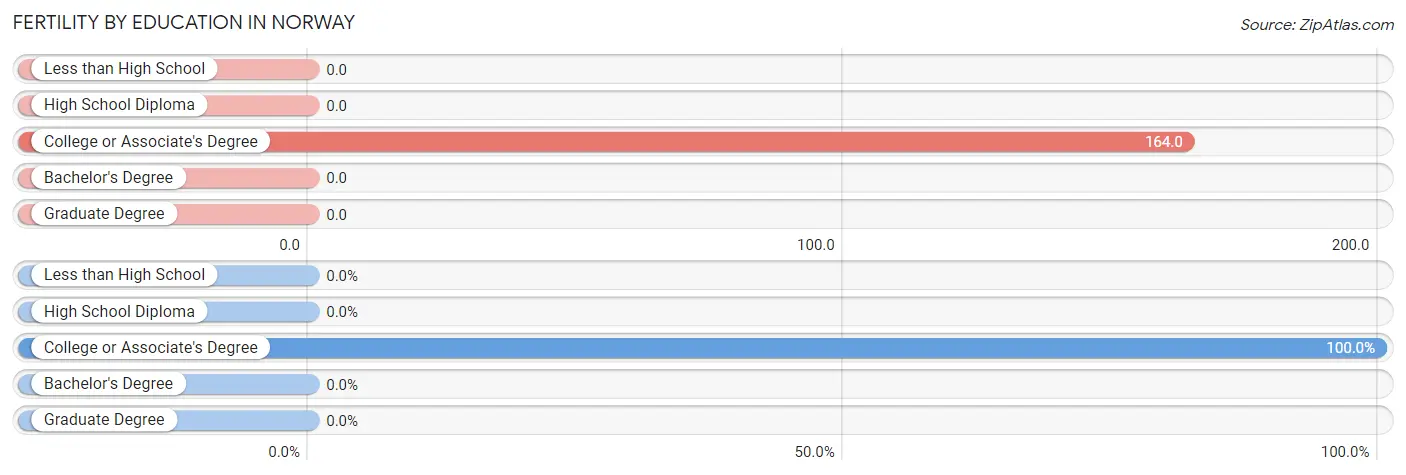
| Educational Attainment | Women with Births | Births / 1,000 Women |
| Less than High School | 0 (0.0%) | 0.0 |
| High School Diploma | 0 (0.0%) | 0.0 |
| College or Associate's Degree | 10 (100.0%) | 164.0 |
| Bachelor's Degree | 0 (0.0%) | 0.0 |
| Graduate Degree | 0 (0.0%) | 0.0 |
| Total | 10 (100.0%) | 99.0 |
Fertility by Education by Marriage Status in Norway

| Educational Attainment | Married | Unmarried |
| Less than High School | 0 (0.0%) | 0 (0.0%) |
| High School Diploma | 0 (0.0%) | 0 (0.0%) |
| College or Associate's Degree | 10 (100.0%) | 0 (0.0%) |
| Bachelor's Degree | 0 (0.0%) | 0 (0.0%) |
| Graduate Degree | 0 (0.0%) | 0 (0.0%) |
| Total | 10 (100.0%) | 0 (0.0%) |
Employment Characteristics in Norway
Employment by Class of Employer in Norway
Among the 322 employed individuals in Norway, private company employees (260 | 80.7%), self-employed (not incorporated) (27 | 8.4%), and local government employees (13 | 4.0%) make up the most common classes of employment.

| Employer Class | # Employees | % Employees |
| Private Company Employees | 260 | 80.7% |
| Self-Employed (Incorporated) | 0 | 0.0% |
| Self-Employed (Not Incorporated) | 27 | 8.4% |
| Not-for-profit Organizations | 10 | 3.1% |
| Local Government Employees | 13 | 4.0% |
| State Government Employees | 6 | 1.9% |
| Federal Government Employees | 6 | 1.9% |
| Unpaid Family Workers | 0 | 0.0% |
| Total | 322 | 100.0% |
Employment Status by Age in Norway
According to the labor force statistics for Norway, out of the total population over 16 years of age (447), 74.0% or 331 individuals are in the labor force, with 0.6% or 2 of them unemployed. The age group with the highest labor force participation rate is 20 to 24 years, with 100.0% or 41 individuals in the labor force. Within the labor force, the 45 to 54 years age range has the highest percentage of unemployed individuals, with 2.4% or 2 of them being unemployed.

| Age Bracket | In Labor Force | Unemployed |
| 16 to 19 Years | 21 (77.8%) | 0 (0.0%) |
| 20 to 24 Years | 41 (100.0%) | 0 (0.0%) |
| 25 to 29 Years | 21 (100.0%) | 0 (0.0%) |
| 30 to 34 Years | 48 (94.1%) | 0 (0.0%) |
| 35 to 44 Years | 23 (92.0%) | 0 (0.0%) |
| 45 to 54 Years | 82 (96.5%) | 2 (2.4%) |
| 55 to 59 Years | 33 (86.8%) | 0 (0.0%) |
| 60 to 64 Years | 39 (61.9%) | 0 (0.0%) |
| 65 to 74 Years | 6 (11.8%) | 0 (0.0%) |
| 75 Years and over | 17 (37.8%) | 0 (0.0%) |
| Total | 331 (74.0%) | 2 (0.6%) |
Employment Status by Educational Attainment in Norway
According to labor force statistics for Norway, 86.9% of individuals (246) out of the total population between 25 and 64 years of age (283) are in the labor force, with 0.8% or 2 of them being unemployed. The group with the highest labor force participation rate are those with the educational attainment of college / associate degree, with 93.3% or 111 individuals in the labor force. Within the labor force, individuals with high school diploma education have the highest percentage of unemployment, with 2.0% or 2 of them being unemployed.

| Educational Attainment | In Labor Force | Unemployed |
| Less than High School | 3 (33.3%) | 0 (0.0%) |
| High School Diploma | 100 (83.3%) | 2 (2.0%) |
| College / Associate Degree | 111 (93.3%) | 0 (0.0%) |
| Bachelor's Degree or higher | 32 (91.4%) | 0 (0.0%) |
| Total | 246 (86.9%) | 2 (0.8%) |
Employment Occupations by Sex in Norway
Management, Business, Science and Arts Occupations
The most common Management, Business, Science and Arts occupations in Norway are Management (40 | 12.2%), Community & Social Service (18 | 5.5%), Computers, Engineering & Science (15 | 4.6%), Architecture & Engineering (13 | 4.0%), and Business & Financial (9 | 2.7%).
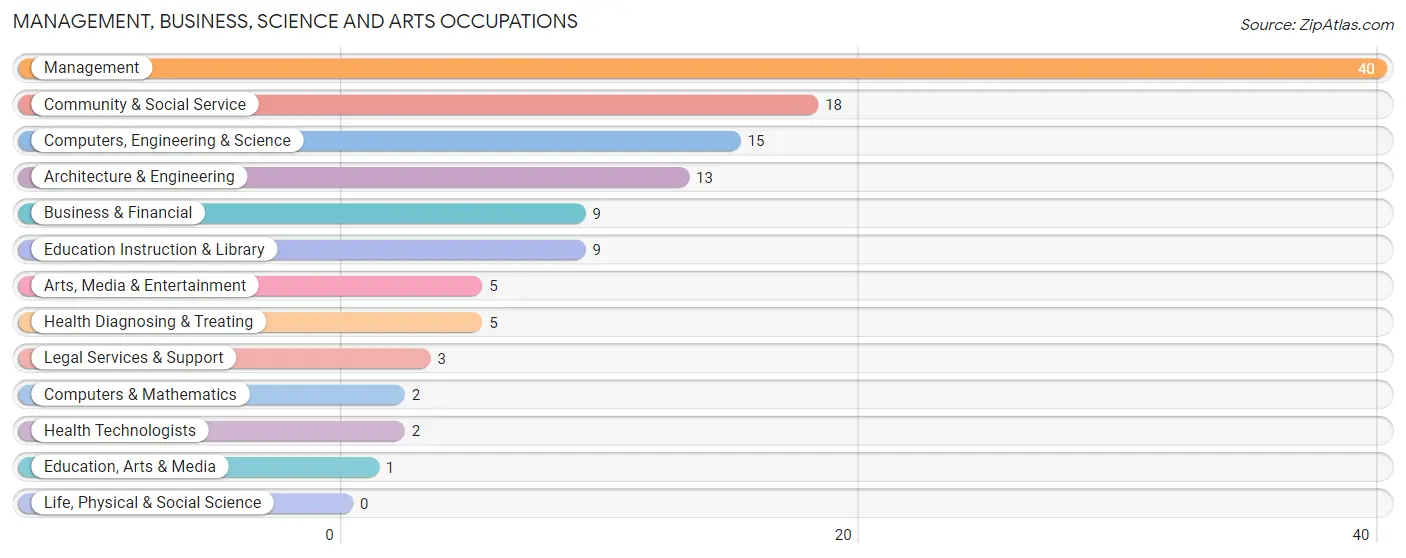
Management, Business, Science and Arts Occupations by Sex
Within the Management, Business, Science and Arts occupations in Norway, the most male-oriented occupations are Education, Arts & Media (100.0%), Business & Financial (77.8%), and Architecture & Engineering (76.9%), while the most female-oriented occupations are Computers & Mathematics (100.0%), Legal Services & Support (100.0%), and Health Diagnosing & Treating (100.0%).
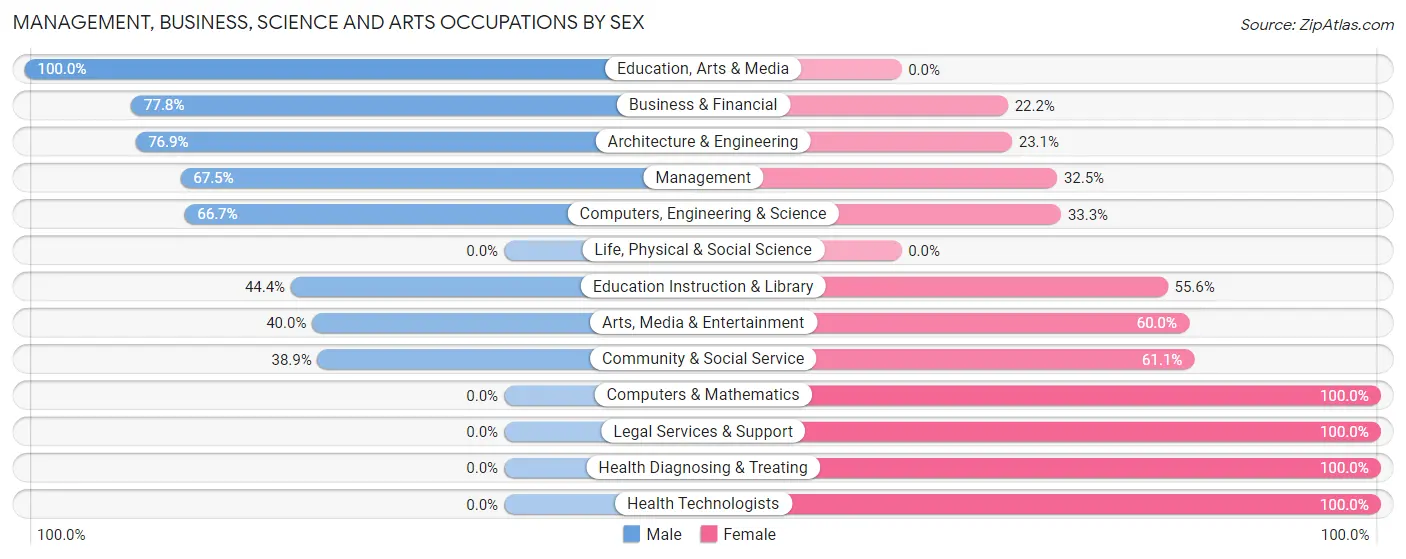
| Occupation | Male | Female |
| Management | 27 (67.5%) | 13 (32.5%) |
| Business & Financial | 7 (77.8%) | 2 (22.2%) |
| Computers, Engineering & Science | 10 (66.7%) | 5 (33.3%) |
| Computers & Mathematics | 0 (0.0%) | 2 (100.0%) |
| Architecture & Engineering | 10 (76.9%) | 3 (23.1%) |
| Life, Physical & Social Science | 0 (0.0%) | 0 (0.0%) |
| Community & Social Service | 7 (38.9%) | 11 (61.1%) |
| Education, Arts & Media | 1 (100.0%) | 0 (0.0%) |
| Legal Services & Support | 0 (0.0%) | 3 (100.0%) |
| Education Instruction & Library | 4 (44.4%) | 5 (55.6%) |
| Arts, Media & Entertainment | 2 (40.0%) | 3 (60.0%) |
| Health Diagnosing & Treating | 0 (0.0%) | 5 (100.0%) |
| Health Technologists | 0 (0.0%) | 2 (100.0%) |
| Total (Category) | 51 (58.6%) | 36 (41.4%) |
| Total (Overall) | 188 (57.1%) | 141 (42.9%) |
Services Occupations
The most common Services occupations in Norway are Cleaning & Maintenance (21 | 6.4%), Food Preparation & Serving (10 | 3.0%), Personal Care & Service (5 | 1.5%), and Healthcare Support (4 | 1.2%).

Services Occupations by Sex

| Occupation | Male | Female |
| Healthcare Support | 0 (0.0%) | 4 (100.0%) |
| Security & Protection | 0 (0.0%) | 0 (0.0%) |
| Firefighting & Prevention | 0 (0.0%) | 0 (0.0%) |
| Law Enforcement | 0 (0.0%) | 0 (0.0%) |
| Food Preparation & Serving | 0 (0.0%) | 10 (100.0%) |
| Cleaning & Maintenance | 16 (76.2%) | 5 (23.8%) |
| Personal Care & Service | 0 (0.0%) | 5 (100.0%) |
| Total (Category) | 16 (40.0%) | 24 (60.0%) |
| Total (Overall) | 188 (57.1%) | 141 (42.9%) |
Sales and Office Occupations
The most common Sales and Office occupations in Norway are Sales & Related (49 | 14.9%), and Office & Administration (45 | 13.7%).

Sales and Office Occupations by Sex

| Occupation | Male | Female |
| Sales & Related | 16 (32.7%) | 33 (67.3%) |
| Office & Administration | 13 (28.9%) | 32 (71.1%) |
| Total (Category) | 29 (30.8%) | 65 (69.2%) |
| Total (Overall) | 188 (57.1%) | 141 (42.9%) |
Natural Resources, Construction and Maintenance Occupations
The most common Natural Resources, Construction and Maintenance occupations in Norway are Construction & Extraction (34 | 10.3%), and Installation, Maintenance & Repair (13 | 4.0%).

Natural Resources, Construction and Maintenance Occupations by Sex

| Occupation | Male | Female |
| Farming, Fishing & Forestry | 0 (0.0%) | 0 (0.0%) |
| Construction & Extraction | 34 (100.0%) | 0 (0.0%) |
| Installation, Maintenance & Repair | 13 (100.0%) | 0 (0.0%) |
| Total (Category) | 47 (100.0%) | 0 (0.0%) |
| Total (Overall) | 188 (57.1%) | 141 (42.9%) |
Production, Transportation and Moving Occupations
The most common Production, Transportation and Moving occupations in Norway are Production (31 | 9.4%), Material Moving (28 | 8.5%), and Transportation (2 | 0.6%).

Production, Transportation and Moving Occupations by Sex

| Occupation | Male | Female |
| Production | 29 (93.5%) | 2 (6.5%) |
| Transportation | 2 (100.0%) | 0 (0.0%) |
| Material Moving | 14 (50.0%) | 14 (50.0%) |
| Total (Category) | 45 (73.8%) | 16 (26.2%) |
| Total (Overall) | 188 (57.1%) | 141 (42.9%) |
Employment Industries by Sex in Norway
Employment Industries in Norway
The major employment industries in Norway include Retail Trade (61 | 18.5%), Manufacturing (60 | 18.2%), Construction (36 | 10.9%), Wholesale Trade (36 | 10.9%), and Finance & Insurance (22 | 6.7%).
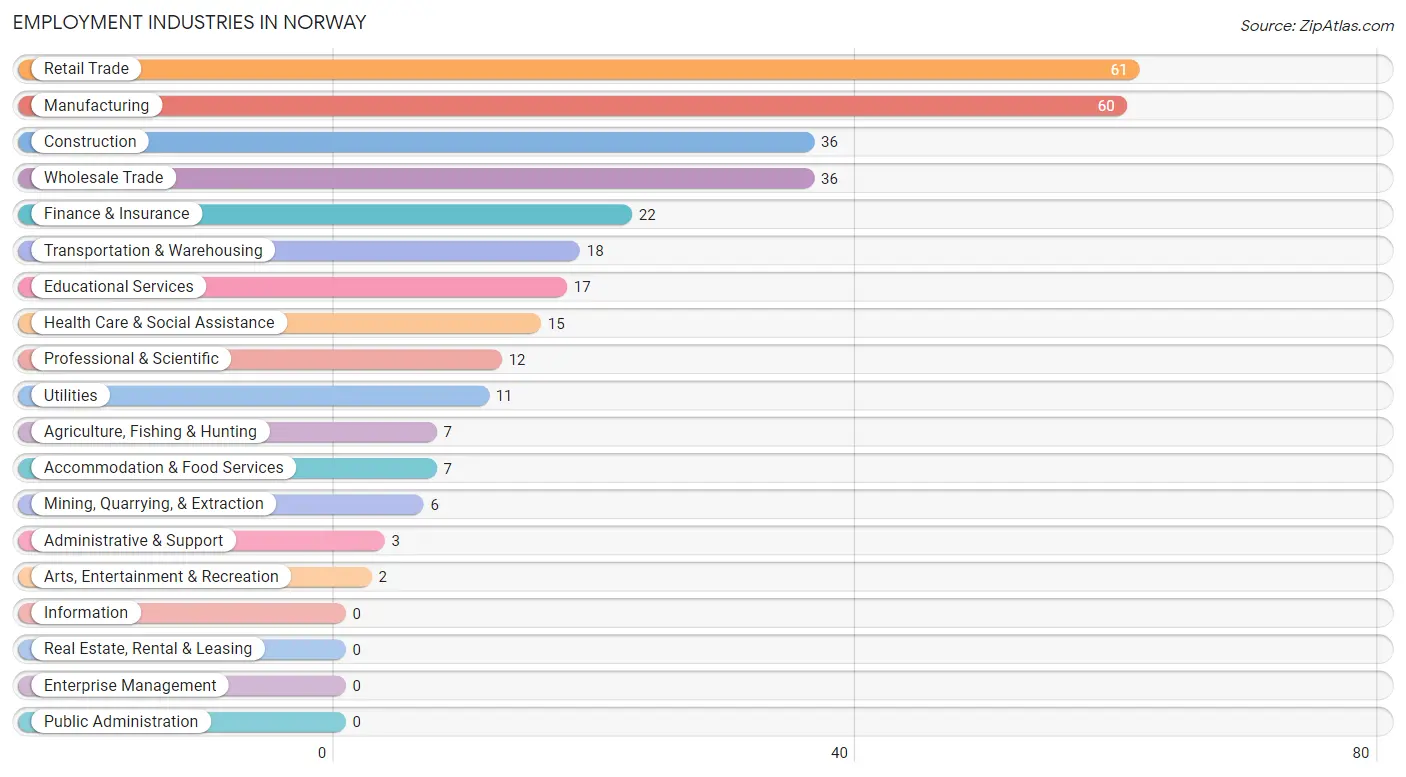
Employment Industries by Sex in Norway
The Norway industries that see more men than women are Agriculture, Fishing & Hunting (100.0%), Mining, Quarrying, & Extraction (100.0%), and Utilities (100.0%), whereas the industries that tend to have a higher number of women are Accommodation & Food Services (100.0%), Retail Trade (73.8%), and Health Care & Social Assistance (73.3%).
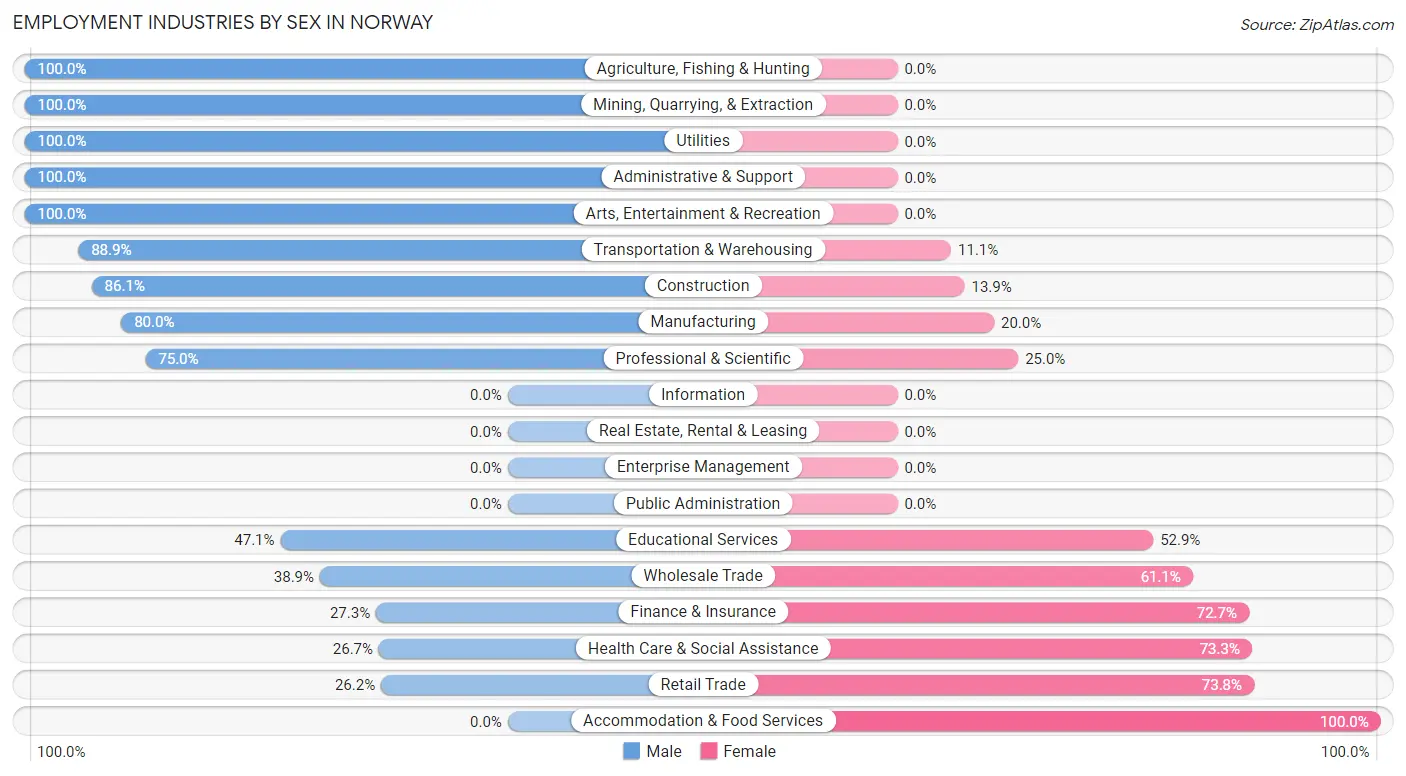
| Industry | Male | Female |
| Agriculture, Fishing & Hunting | 7 (100.0%) | 0 (0.0%) |
| Mining, Quarrying, & Extraction | 6 (100.0%) | 0 (0.0%) |
| Construction | 31 (86.1%) | 5 (13.9%) |
| Manufacturing | 48 (80.0%) | 12 (20.0%) |
| Wholesale Trade | 14 (38.9%) | 22 (61.1%) |
| Retail Trade | 16 (26.2%) | 45 (73.8%) |
| Transportation & Warehousing | 16 (88.9%) | 2 (11.1%) |
| Utilities | 11 (100.0%) | 0 (0.0%) |
| Information | 0 (0.0%) | 0 (0.0%) |
| Finance & Insurance | 6 (27.3%) | 16 (72.7%) |
| Real Estate, Rental & Leasing | 0 (0.0%) | 0 (0.0%) |
| Professional & Scientific | 9 (75.0%) | 3 (25.0%) |
| Enterprise Management | 0 (0.0%) | 0 (0.0%) |
| Administrative & Support | 3 (100.0%) | 0 (0.0%) |
| Educational Services | 8 (47.1%) | 9 (52.9%) |
| Health Care & Social Assistance | 4 (26.7%) | 11 (73.3%) |
| Arts, Entertainment & Recreation | 2 (100.0%) | 0 (0.0%) |
| Accommodation & Food Services | 0 (0.0%) | 7 (100.0%) |
| Public Administration | 0 (0.0%) | 0 (0.0%) |
| Total | 188 (57.1%) | 141 (42.9%) |
Education in Norway
School Enrollment in Norway
The most common levels of schooling among the 50 students in Norway are high school (13 | 26.0%), elementary school (12 | 24.0%), and middle school (8 | 16.0%).

| School Level | # Students | % Students |
| Nursery / Preschool | 6 | 12.0% |
| Kindergarten | 0 | 0.0% |
| Elementary School | 12 | 24.0% |
| Middle School | 8 | 16.0% |
| High School | 13 | 26.0% |
| College / Undergraduate | 5 | 10.0% |
| Graduate / Professional | 6 | 12.0% |
| Total | 50 | 100.0% |
School Enrollment by Age by Funding Source in Norway
Out of a total of 50 students who are enrolled in schools in Norway, 8 (16.0%) attend a private institution, while the remaining 42 (84.0%) are enrolled in public schools. The age group of 35 years and over has the highest likelihood of being enrolled in private schools, with 2 (100.0% in the age bracket) enrolled. Conversely, the age group of 3 to 4 year olds has the lowest likelihood of being enrolled in a private school, with 4 (100.0% in the age bracket) attending a public institution.

| Age Bracket | Public School | Private School |
| 3 to 4 Year Olds | 4 (100.0%) | 0 (0.0%) |
| 5 to 9 Year Old | 10 (83.3%) | 2 (16.7%) |
| 10 to 14 Year Olds | 10 (100.0%) | 0 (0.0%) |
| 15 to 17 Year Olds | 10 (100.0%) | 0 (0.0%) |
| 18 to 19 Year Olds | 6 (100.0%) | 0 (0.0%) |
| 20 to 24 Year Olds | 0 (0.0%) | 0 (0.0%) |
| 25 to 34 Year Olds | 2 (33.3%) | 4 (66.7%) |
| 35 Years and over | 0 (0.0%) | 2 (100.0%) |
| Total | 42 (84.0%) | 8 (16.0%) |
Educational Attainment by Field of Study in Norway
Business (14 | 28.6%), psychology (10 | 20.4%), science & technology (9 | 18.4%), bio, nature & agricultural (7 | 14.3%), and liberal arts & history (3 | 6.1%) are the most common fields of study among 49 individuals in Norway who have obtained a bachelor's degree or higher.
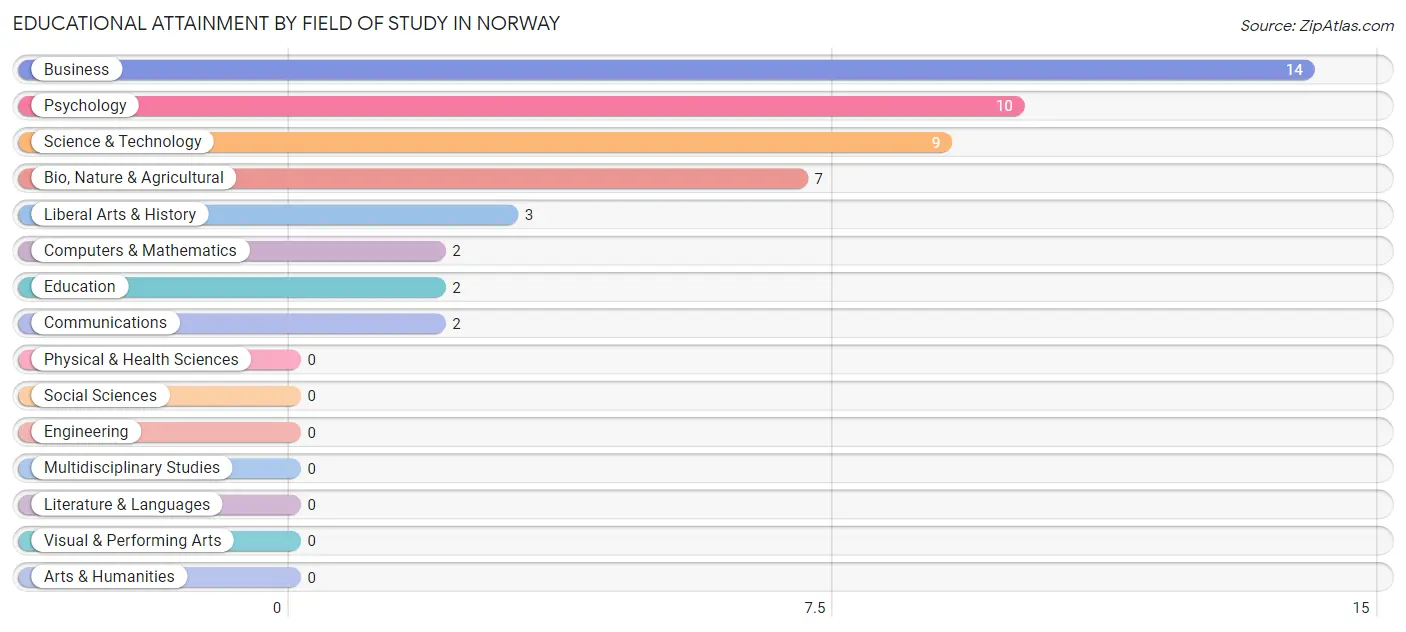
| Field of Study | # Graduates | % Graduates |
| Computers & Mathematics | 2 | 4.1% |
| Bio, Nature & Agricultural | 7 | 14.3% |
| Physical & Health Sciences | 0 | 0.0% |
| Psychology | 10 | 20.4% |
| Social Sciences | 0 | 0.0% |
| Engineering | 0 | 0.0% |
| Multidisciplinary Studies | 0 | 0.0% |
| Science & Technology | 9 | 18.4% |
| Business | 14 | 28.6% |
| Education | 2 | 4.1% |
| Literature & Languages | 0 | 0.0% |
| Liberal Arts & History | 3 | 6.1% |
| Visual & Performing Arts | 0 | 0.0% |
| Communications | 2 | 4.1% |
| Arts & Humanities | 0 | 0.0% |
| Total | 49 | 100.0% |
Transportation & Commute in Norway
Vehicle Availability by Sex in Norway
The most prevalent vehicle ownership categories in Norway are males with 2 vehicles (67, accounting for 36.0%) and females with 2 vehicles (59, making up 49.3%).

| Vehicles Available | Male | Female |
| No Vehicle | 2 (1.1%) | 0 (0.0%) |
| 1 Vehicle | 24 (12.9%) | 8 (5.9%) |
| 2 Vehicles | 67 (36.0%) | 59 (43.4%) |
| 3 Vehicles | 38 (20.4%) | 33 (24.3%) |
| 4 Vehicles | 30 (16.1%) | 11 (8.1%) |
| 5 or more Vehicles | 25 (13.4%) | 25 (18.4%) |
| Total | 186 (100.0%) | 136 (100.0%) |
Commute Time in Norway
The most frequently occuring commute durations in Norway are 30 to 34 minutes (61 commuters, 20.3%), 25 to 29 minutes (56 commuters, 18.7%), and 5 to 9 minutes (55 commuters, 18.3%).
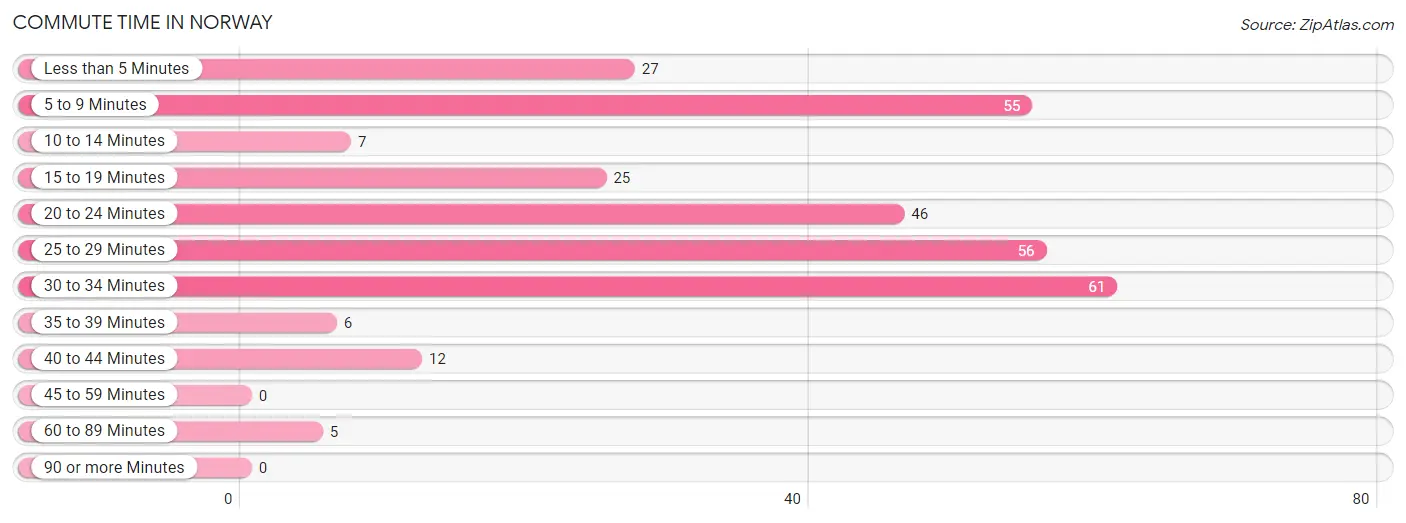
| Commute Time | # Commuters | % Commuters |
| Less than 5 Minutes | 27 | 9.0% |
| 5 to 9 Minutes | 55 | 18.3% |
| 10 to 14 Minutes | 7 | 2.3% |
| 15 to 19 Minutes | 25 | 8.3% |
| 20 to 24 Minutes | 46 | 15.3% |
| 25 to 29 Minutes | 56 | 18.7% |
| 30 to 34 Minutes | 61 | 20.3% |
| 35 to 39 Minutes | 6 | 2.0% |
| 40 to 44 Minutes | 12 | 4.0% |
| 45 to 59 Minutes | 0 | 0.0% |
| 60 to 89 Minutes | 5 | 1.7% |
| 90 or more Minutes | 0 | 0.0% |
Commute Time by Sex in Norway
The most common commute times in Norway are 25 to 29 minutes (46 commuters, 25.7%) for males and 30 to 34 minutes (37 commuters, 30.6%) for females.
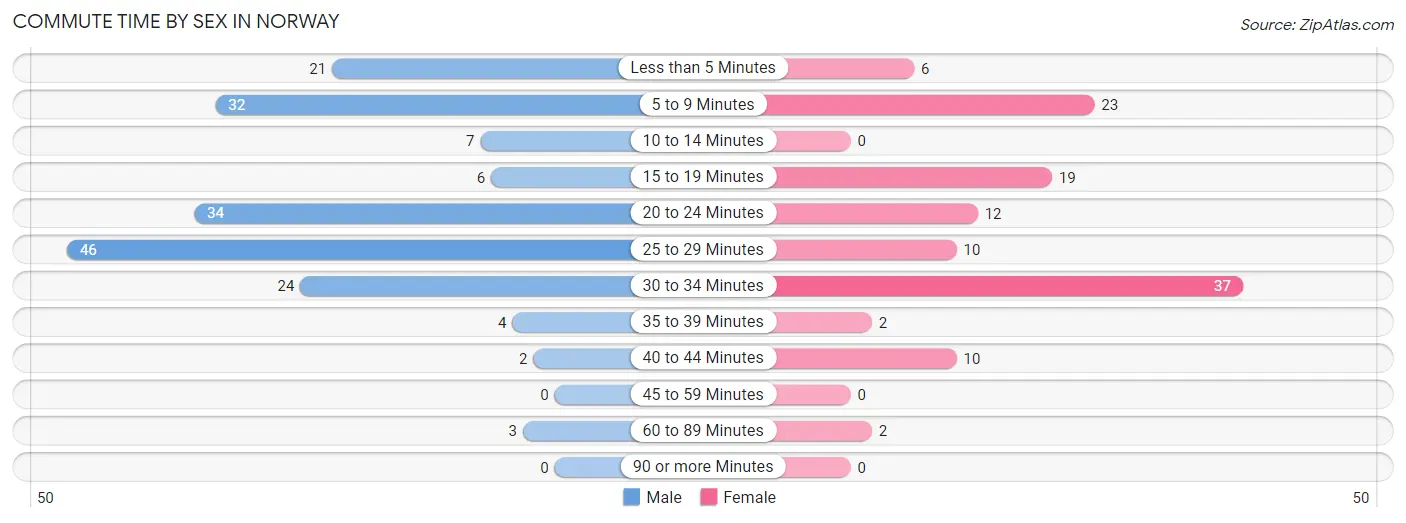
| Commute Time | Male | Female |
| Less than 5 Minutes | 21 (11.7%) | 6 (5.0%) |
| 5 to 9 Minutes | 32 (17.9%) | 23 (19.0%) |
| 10 to 14 Minutes | 7 (3.9%) | 0 (0.0%) |
| 15 to 19 Minutes | 6 (3.4%) | 19 (15.7%) |
| 20 to 24 Minutes | 34 (19.0%) | 12 (9.9%) |
| 25 to 29 Minutes | 46 (25.7%) | 10 (8.3%) |
| 30 to 34 Minutes | 24 (13.4%) | 37 (30.6%) |
| 35 to 39 Minutes | 4 (2.2%) | 2 (1.7%) |
| 40 to 44 Minutes | 2 (1.1%) | 10 (8.3%) |
| 45 to 59 Minutes | 0 (0.0%) | 0 (0.0%) |
| 60 to 89 Minutes | 3 (1.7%) | 2 (1.7%) |
| 90 or more Minutes | 0 (0.0%) | 0 (0.0%) |
Time of Departure to Work by Sex in Norway
The most frequent times of departure to work in Norway are 6:30 AM to 6:59 AM (34, 19.0%) for males and 8:00 AM to 8:29 AM (28, 23.1%) for females.
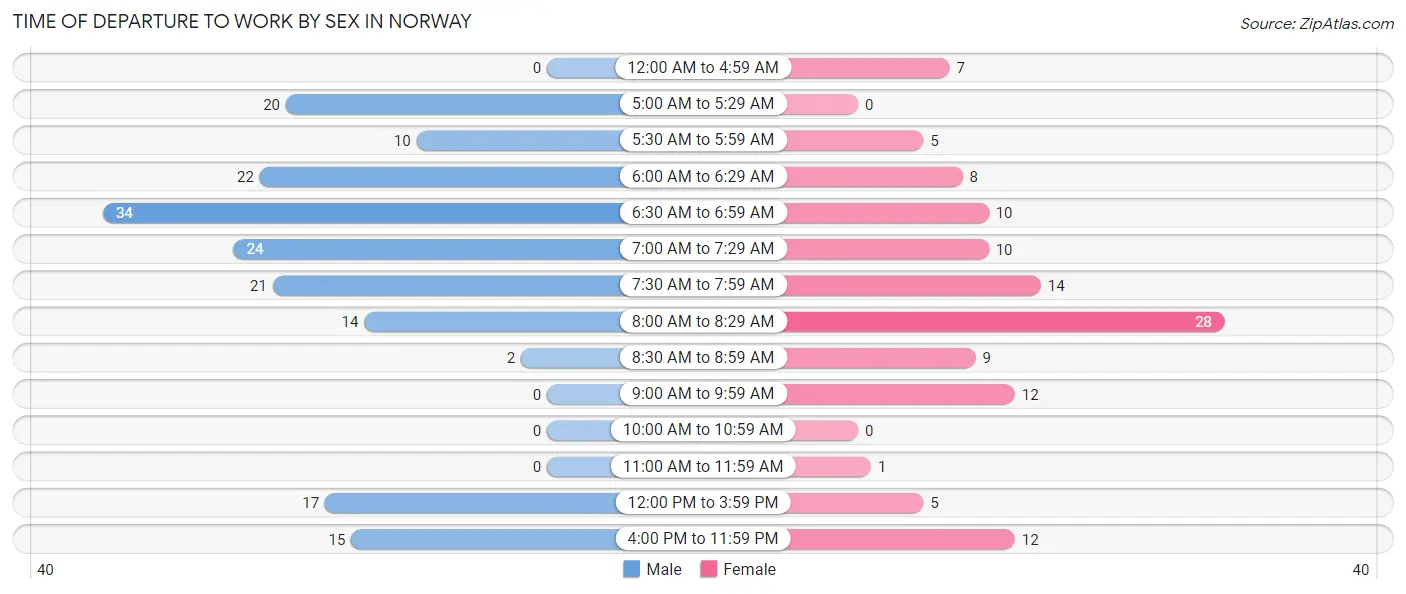
| Time of Departure | Male | Female |
| 12:00 AM to 4:59 AM | 0 (0.0%) | 7 (5.8%) |
| 5:00 AM to 5:29 AM | 20 (11.2%) | 0 (0.0%) |
| 5:30 AM to 5:59 AM | 10 (5.6%) | 5 (4.1%) |
| 6:00 AM to 6:29 AM | 22 (12.3%) | 8 (6.6%) |
| 6:30 AM to 6:59 AM | 34 (19.0%) | 10 (8.3%) |
| 7:00 AM to 7:29 AM | 24 (13.4%) | 10 (8.3%) |
| 7:30 AM to 7:59 AM | 21 (11.7%) | 14 (11.6%) |
| 8:00 AM to 8:29 AM | 14 (7.8%) | 28 (23.1%) |
| 8:30 AM to 8:59 AM | 2 (1.1%) | 9 (7.4%) |
| 9:00 AM to 9:59 AM | 0 (0.0%) | 12 (9.9%) |
| 10:00 AM to 10:59 AM | 0 (0.0%) | 0 (0.0%) |
| 11:00 AM to 11:59 AM | 0 (0.0%) | 1 (0.8%) |
| 12:00 PM to 3:59 PM | 17 (9.5%) | 5 (4.1%) |
| 4:00 PM to 11:59 PM | 15 (8.4%) | 12 (9.9%) |
| Total | 179 (100.0%) | 121 (100.0%) |
Housing Occupancy in Norway
Occupancy by Ownership in Norway
Of the total 218 dwellings in Norway, owner-occupied units account for 194 (89.0%), while renter-occupied units make up 24 (11.0%).

| Occupancy | # Housing Units | % Housing Units |
| Owner Occupied Housing Units | 194 | 89.0% |
| Renter-Occupied Housing Units | 24 | 11.0% |
| Total Occupied Housing Units | 218 | 100.0% |
Occupancy by Household Size in Norway

| Household Size | # Housing Units | % Housing Units |
| 1-Person Household | 73 | 33.5% |
| 2-Person Household | 79 | 36.2% |
| 3-Person Household | 29 | 13.3% |
| 4+ Person Household | 37 | 17.0% |
| Total Housing Units | 218 | 100.0% |
Occupancy by Ownership by Household Size in Norway

| Household Size | Owner-occupied | Renter-occupied |
| 1-Person Household | 53 (72.6%) | 20 (27.4%) |
| 2-Person Household | 79 (100.0%) | 0 (0.0%) |
| 3-Person Household | 27 (93.1%) | 2 (6.9%) |
| 4+ Person Household | 35 (94.6%) | 2 (5.4%) |
| Total Housing Units | 194 (89.0%) | 24 (11.0%) |
Occupancy by Educational Attainment in Norway

| Household Size | Owner-occupied | Renter-occupied |
| Less than High School | 6 (100.0%) | 0 (0.0%) |
| High School Diploma | 77 (81.9%) | 17 (18.1%) |
| College/Associate Degree | 89 (95.7%) | 4 (4.3%) |
| Bachelor's Degree or higher | 22 (88.0%) | 3 (12.0%) |
Occupancy by Age of Householder in Norway

| Age Bracket | # Households | % Households |
| Under 35 Years | 44 | 20.2% |
| 35 to 44 Years | 9 | 4.1% |
| 45 to 54 Years | 57 | 26.2% |
| 55 to 64 Years | 56 | 25.7% |
| 65 to 74 Years | 21 | 9.6% |
| 75 to 84 Years | 20 | 9.2% |
| 85 Years and Over | 11 | 5.1% |
| Total | 218 | 100.0% |
Housing Finances in Norway
Median Income by Occupancy in Norway

| Occupancy Type | # Households | Median Income |
| Owner-Occupied | 194 (89.0%) | $96,364 |
| Renter-Occupied | 24 (11.0%) | $58,125 |
| Average | 218 (100.0%) | $90,000 |
Occupancy by Householder Income Bracket in Norway
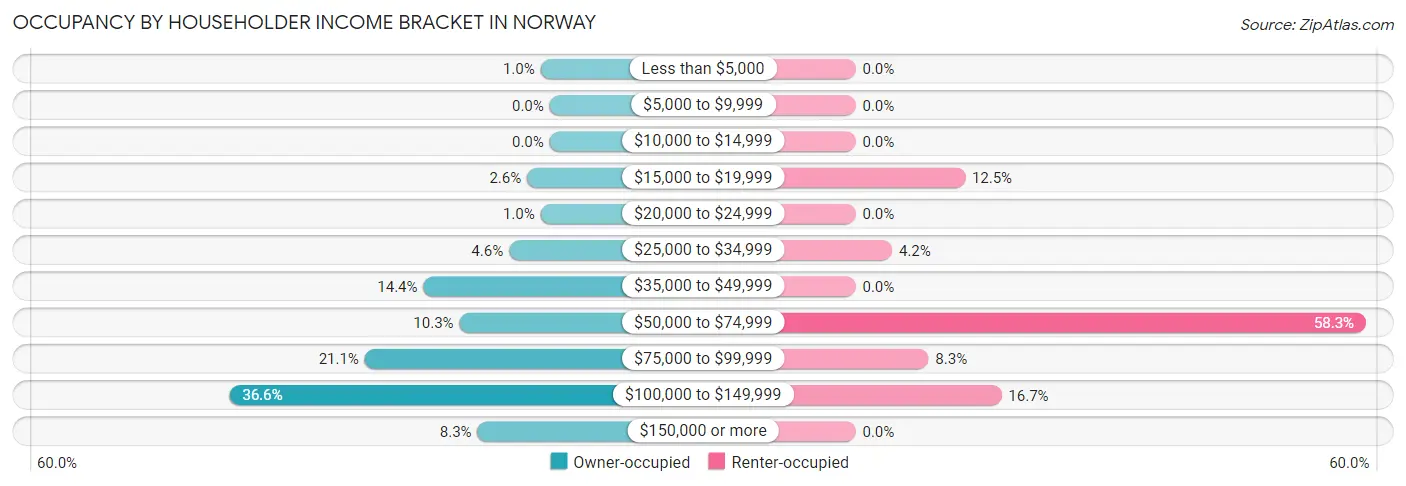
| Income Bracket | Owner-occupied | Renter-occupied |
| Less than $5,000 | 2 (1.0%) | 0 (0.0%) |
| $5,000 to $9,999 | 0 (0.0%) | 0 (0.0%) |
| $10,000 to $14,999 | 0 (0.0%) | 0 (0.0%) |
| $15,000 to $19,999 | 5 (2.6%) | 3 (12.5%) |
| $20,000 to $24,999 | 2 (1.0%) | 0 (0.0%) |
| $25,000 to $34,999 | 9 (4.6%) | 1 (4.2%) |
| $35,000 to $49,999 | 28 (14.4%) | 0 (0.0%) |
| $50,000 to $74,999 | 20 (10.3%) | 14 (58.3%) |
| $75,000 to $99,999 | 41 (21.1%) | 2 (8.3%) |
| $100,000 to $149,999 | 71 (36.6%) | 4 (16.7%) |
| $150,000 or more | 16 (8.3%) | 0 (0.0%) |
| Total | 194 (100.0%) | 24 (100.0%) |
Monthly Housing Cost Tiers in Norway

| Monthly Cost | Owner-occupied | Renter-occupied |
| Less than $300 | 12 (6.2%) | 0 (0.0%) |
| $300 to $499 | 17 (8.8%) | 0 (0.0%) |
| $500 to $799 | 41 (21.1%) | 16 (66.7%) |
| $800 to $999 | 40 (20.6%) | 2 (8.3%) |
| $1,000 to $1,499 | 40 (20.6%) | 2 (8.3%) |
| $1,500 to $1,999 | 33 (17.0%) | 0 (0.0%) |
| $2,000 to $2,499 | 11 (5.7%) | 0 (0.0%) |
| $2,500 to $2,999 | 0 (0.0%) | 0 (0.0%) |
| $3,000 or more | 0 (0.0%) | 0 (0.0%) |
| Total | 194 (100.0%) | 24 (100.0%) |
Physical Housing Characteristics in Norway
Housing Structures in Norway

| Structure Type | # Housing Units | % Housing Units |
| Single Unit, Detached | 199 | 91.3% |
| Single Unit, Attached | 2 | 0.9% |
| 2 Unit Apartments | 0 | 0.0% |
| 3 or 4 Unit Apartments | 9 | 4.1% |
| 5 to 9 Unit Apartments | 8 | 3.7% |
| 10 or more Apartments | 0 | 0.0% |
| Mobile Home / Other | 0 | 0.0% |
| Total | 218 | 100.0% |
Housing Structures by Occupancy in Norway

| Structure Type | Owner-occupied | Renter-occupied |
| Single Unit, Detached | 189 (95.0%) | 10 (5.0%) |
| Single Unit, Attached | 2 (100.0%) | 0 (0.0%) |
| 2 Unit Apartments | 0 (0.0%) | 0 (0.0%) |
| 3 or 4 Unit Apartments | 3 (33.3%) | 6 (66.7%) |
| 5 to 9 Unit Apartments | 0 (0.0%) | 8 (100.0%) |
| 10 or more Apartments | 0 (0.0%) | 0 (0.0%) |
| Mobile Home / Other | 0 (0.0%) | 0 (0.0%) |
| Total | 194 (89.0%) | 24 (11.0%) |
Housing Structures by Number of Rooms in Norway

| Number of Rooms | Owner-occupied | Renter-occupied |
| 1 Room | 0 (0.0%) | 0 (0.0%) |
| 2 or 3 Rooms | 7 (3.6%) | 6 (25.0%) |
| 4 or 5 Rooms | 66 (34.0%) | 10 (41.7%) |
| 6 or 7 Rooms | 53 (27.3%) | 0 (0.0%) |
| 8 or more Rooms | 68 (35.0%) | 8 (33.3%) |
| Total | 194 (100.0%) | 24 (100.0%) |
Housing Structure by Heating Type in Norway

| Heating Type | Owner-occupied | Renter-occupied |
| Utility Gas | 160 (82.5%) | 5 (20.8%) |
| Bottled, Tank, or LP Gas | 7 (3.6%) | 3 (12.5%) |
| Electricity | 24 (12.4%) | 14 (58.3%) |
| Fuel Oil or Kerosene | 0 (0.0%) | 0 (0.0%) |
| Coal or Coke | 0 (0.0%) | 0 (0.0%) |
| All other Fuels | 3 (1.5%) | 0 (0.0%) |
| No Fuel Used | 0 (0.0%) | 2 (8.3%) |
| Total | 194 (100.0%) | 24 (100.0%) |
Household Vehicle Usage in Norway

| Vehicles per Household | Owner-occupied | Renter-occupied |
| No Vehicle | 0 (0.0%) | 2 (8.3%) |
| 1 Vehicle | 37 (19.1%) | 9 (37.5%) |
| 2 Vehicles | 92 (47.4%) | 8 (33.3%) |
| 3 or more Vehicles | 65 (33.5%) | 5 (20.8%) |
| Total | 194 (100.0%) | 24 (100.0%) |
Real Estate & Mortgages in Norway
Real Estate and Mortgage Overview in Norway
| Characteristic | Without Mortgage | With Mortgage |
| Housing Units | 77 | 117 |
| Median Property Value | $143,800 | $149,600 |
| Median Household Income | $86,875 | $10 |
| Monthly Housing Costs | $608 | $0 |
| Real Estate Taxes | $1,972 | $0 |
Property Value by Mortgage Status in Norway

| Property Value | Without Mortgage | With Mortgage |
| Less than $50,000 | 2 (2.6%) | 0 (0.0%) |
| $50,000 to $99,999 | 21 (27.3%) | 19 (16.2%) |
| $100,000 to $299,999 | 54 (70.1%) | 88 (75.2%) |
| $300,000 to $499,999 | 0 (0.0%) | 10 (8.6%) |
| $500,000 to $749,999 | 0 (0.0%) | 0 (0.0%) |
| $750,000 to $999,999 | 0 (0.0%) | 0 (0.0%) |
| $1,000,000 or more | 0 (0.0%) | 0 (0.0%) |
| Total | 77 (100.0%) | 117 (100.0%) |
Household Income by Mortgage Status in Norway

| Household Income | Without Mortgage | With Mortgage |
| Less than $10,000 | 2 (2.6%) | 0 (0.0%) |
| $10,000 to $24,999 | 7 (9.1%) | 0 (0.0%) |
| $25,000 to $34,999 | 5 (6.5%) | 0 (0.0%) |
| $35,000 to $49,999 | 5 (6.5%) | 4 (3.4%) |
| $50,000 to $74,999 | 6 (7.8%) | 23 (19.7%) |
| $75,000 to $99,999 | 16 (20.8%) | 14 (12.0%) |
| $100,000 to $149,999 | 30 (39.0%) | 25 (21.4%) |
| $150,000 or more | 6 (7.8%) | 41 (35.0%) |
| Total | 77 (100.0%) | 117 (100.0%) |
Property Value to Household Income Ratio in Norway

| Value-to-Income Ratio | Without Mortgage | With Mortgage |
| Less than 2.0x | 46 (59.7%) | 96,806 (82,740.2%) |
| 2.0x to 2.9x | 12 (15.6%) | 65 (55.6%) |
| 3.0x to 3.9x | 4 (5.2%) | 40 (34.2%) |
| 4.0x or more | 15 (19.5%) | 6 (5.1%) |
| Total | 77 (100.0%) | 117 (100.0%) |
Real Estate Taxes by Mortgage Status in Norway

| Property Taxes | Without Mortgage | With Mortgage |
| Less than $800 | 8 (10.4%) | 0 (0.0%) |
| $800 to $1,499 | 22 (28.6%) | 3 (2.6%) |
| $800 to $1,499 | 47 (61.0%) | 26 (22.2%) |
| Total | 77 (100.0%) | 117 (100.0%) |
Health & Disability in Norway
Health Insurance Coverage by Age in Norway

| Age Bracket | With Coverage | Without Coverage |
| Under 6 Years | 45 (100.0%) | 0 (0.0%) |
| 6 to 18 Years | 37 (100.0%) | 0 (0.0%) |
| 19 to 25 Years | 60 (100.0%) | 0 (0.0%) |
| 26 to 34 Years | 67 (100.0%) | 0 (0.0%) |
| 35 to 44 Years | 23 (92.0%) | 2 (8.0%) |
| 45 to 54 Years | 85 (100.0%) | 0 (0.0%) |
| 55 to 64 Years | 101 (100.0%) | 0 (0.0%) |
| 65 to 74 Years | 51 (100.0%) | 0 (0.0%) |
| 75 Years and older | 45 (100.0%) | 0 (0.0%) |
| Total | 514 (99.6%) | 2 (0.4%) |
Health Insurance Coverage by Citizenship Status in Norway

| Citizenship Status | With Coverage | Without Coverage |
| Native Born | 45 (100.0%) | 0 (0.0%) |
| Foreign Born, Citizen | 37 (100.0%) | 0 (0.0%) |
| Foreign Born, not a Citizen | 60 (100.0%) | 0 (0.0%) |
Health Insurance Coverage by Household Income in Norway

| Household Income | With Coverage | Without Coverage |
| Under $25,000 | 15 (100.0%) | 0 (0.0%) |
| $25,000 to $49,999 | 62 (100.0%) | 0 (0.0%) |
| $50,000 to $74,999 | 56 (96.6%) | 2 (3.5%) |
| $75,000 to $99,999 | 119 (100.0%) | 0 (0.0%) |
| $100,000 and over | 262 (100.0%) | 0 (0.0%) |
Public vs Private Health Insurance Coverage by Age in Norway

| Age Bracket | Public Insurance | Private Insurance |
| Under 6 | 1 (2.2%) | 44 (97.8%) |
| 6 to 18 Years | 5 (13.5%) | 32 (86.5%) |
| 19 to 25 Years | 4 (6.7%) | 56 (93.3%) |
| 25 to 34 Years | 3 (4.5%) | 64 (95.5%) |
| 35 to 44 Years | 2 (8.0%) | 21 (84.0%) |
| 45 to 54 Years | 7 (8.2%) | 83 (97.7%) |
| 55 to 64 Years | 12 (11.9%) | 89 (88.1%) |
| 65 to 74 Years | 49 (96.1%) | 24 (47.1%) |
| 75 Years and over | 45 (100.0%) | 30 (66.7%) |
| Total | 128 (24.8%) | 443 (85.9%) |
Disability Status by Sex by Age in Norway

| Age Bracket | Male | Female |
| Under 5 Years | 0 (0.0%) | 0 (0.0%) |
| 5 to 17 Years | 3 (20.0%) | 0 (0.0%) |
| 18 to 34 Years | 0 (0.0%) | 0 (0.0%) |
| 35 to 64 Years | 14 (12.1%) | 7 (7.4%) |
| 65 to 74 Years | 0 (0.0%) | 0 (0.0%) |
| 75 Years and over | 10 (45.5%) | 10 (43.5%) |
Disability Class by Sex by Age in Norway
Disability Class: Hearing Difficulty

| Age Bracket | Male | Female |
| Under 5 Years | 0 (0.0%) | 0 (0.0%) |
| 5 to 17 Years | 0 (0.0%) | 0 (0.0%) |
| 18 to 34 Years | 0 (0.0%) | 0 (0.0%) |
| 35 to 64 Years | 0 (0.0%) | 2 (2.1%) |
| 65 to 74 Years | 0 (0.0%) | 0 (0.0%) |
| 75 Years and over | 7 (31.8%) | 3 (13.0%) |
Disability Class: Vision Difficulty

| Age Bracket | Male | Female |
| Under 5 Years | 0 (0.0%) | 0 (0.0%) |
| 5 to 17 Years | 0 (0.0%) | 0 (0.0%) |
| 18 to 34 Years | 0 (0.0%) | 0 (0.0%) |
| 35 to 64 Years | 0 (0.0%) | 0 (0.0%) |
| 65 to 74 Years | 0 (0.0%) | 0 (0.0%) |
| 75 Years and over | 3 (13.6%) | 0 (0.0%) |
Disability Class: Cognitive Difficulty

| Age Bracket | Male | Female |
| 5 to 17 Years | 3 (20.0%) | 0 (0.0%) |
| 18 to 34 Years | 0 (0.0%) | 0 (0.0%) |
| 35 to 64 Years | 6 (5.2%) | 2 (2.1%) |
| 65 to 74 Years | 0 (0.0%) | 0 (0.0%) |
| 75 Years and over | 0 (0.0%) | 0 (0.0%) |
Disability Class: Ambulatory Difficulty

| Age Bracket | Male | Female |
| 5 to 17 Years | 0 (0.0%) | 0 (0.0%) |
| 18 to 34 Years | 0 (0.0%) | 0 (0.0%) |
| 35 to 64 Years | 8 (6.9%) | 5 (5.3%) |
| 65 to 74 Years | 0 (0.0%) | 0 (0.0%) |
| 75 Years and over | 5 (22.7%) | 8 (34.8%) |
Disability Class: Self-Care Difficulty

| Age Bracket | Male | Female |
| 5 to 17 Years | 3 (20.0%) | 0 (0.0%) |
| 18 to 34 Years | 0 (0.0%) | 0 (0.0%) |
| 35 to 64 Years | 0 (0.0%) | 0 (0.0%) |
| 65 to 74 Years | 0 (0.0%) | 0 (0.0%) |
| 75 Years and over | 0 (0.0%) | 5 (21.7%) |
Technology Access in Norway
Computing Device Access in Norway

| Device Type | # Households | % Households |
| Desktop or Laptop | 161 | 73.9% |
| Smartphone | 197 | 90.4% |
| Tablet | 131 | 60.1% |
| No Computing Device | 4 | 1.8% |
| Total | 218 | 100.0% |
Internet Access in Norway

| Internet Type | # Households | % Households |
| Dial-Up Internet | 0 | 0.0% |
| Broadband Home | 155 | 71.1% |
| Cellular Data Only | 25 | 11.5% |
| Satellite Internet | 3 | 1.4% |
| No Internet | 35 | 16.1% |
| Total | 218 | 100.0% |
Norway Summary
Norway, Iowa is a small town located in Mitchell County, Iowa, United States. It is situated on the banks of the Cedar River, and is part of the Mason City Micropolitan Statistical Area. The population of Norway was estimated to be 545 in the year 2020.
History
Norway was founded in 1856 by Norwegian immigrants who had settled in the area. The town was named after the country of Norway, and the first settlers were mostly farmers. The town was incorporated in 1876, and the first mayor was Ole O. Olson.
In the late 19th century, Norway was a thriving agricultural community, with a variety of crops being grown in the area. The town also had a number of businesses, including a general store, a blacksmith shop, a hotel, and a sawmill.
In the early 20th century, Norway experienced a period of growth and prosperity. The town was home to a number of businesses, including a bank, a newspaper, a creamery, and a lumberyard. The town also had a number of churches, including the Norwegian Lutheran Church, which was founded in 1876.
Geography
Norway is located in Mitchell County, Iowa, in the north-central part of the state. The town is situated on the banks of the Cedar River, and is part of the Mason City Micropolitan Statistical Area. The town is located approximately 30 miles north of Mason City, and is about an hour and a half drive from Des Moines.
The terrain around Norway is mostly flat, with some rolling hills. The town is surrounded by farmland, and the area is known for its fertile soil. The climate in Norway is generally mild, with hot summers and cold winters.
Economy
The economy of Norway is largely based on agriculture. The town is home to a number of farms, and the surrounding area is known for its fertile soil. The town also has a number of businesses, including a bank, a newspaper, a creamery, and a lumberyard.
The town is also home to a number of manufacturing companies, including a furniture factory, a metal fabrication plant, and a plastics factory. The town is also home to a number of retail stores, including a grocery store, a hardware store, and a clothing store.
Demographics
As of the 2020 census, the population of Norway was estimated to be 545. The racial makeup of the town was 97.3% White, 0.7% African American, 0.2% Native American, 0.2% Asian, 0.2% from other races, and 1.6% from two or more races. The median household income in Norway was $45,000, and the median family income was $50,000.
Conclusion
Norway, Iowa is a small town located in Mitchell County, Iowa, United States. It is situated on the banks of the Cedar River, and is part of the Mason City Micropolitan Statistical Area. The town was founded in 1856 by Norwegian immigrants, and has since grown into a thriving agricultural community. The town is home to a number of businesses, and the economy is largely based on agriculture. The population of Norway was estimated to be 545 in the year 2020, and the racial makeup of the town was 97.3% White.
Common Questions
What is Per Capita Income in Norway?
Per Capita income in Norway is $40,856.
What is the Median Family Income in Norway?
Median Family Income in Norway is $101,000.
What is the Median Household income in Norway?
Median Household Income in Norway is $90,000.
What is Income or Wage Gap in Norway?
Income or Wage Gap in Norway is 37.5%.
Women in Norway earn 62.5 cents for every dollar earned by a man.
What is Inequality or Gini Index in Norway?
Inequality or Gini Index in Norway is 0.31.
What is the Total Population of Norway?
Total Population of Norway is 516.
What is the Total Male Population of Norway?
Total Male Population of Norway is 292.
What is the Total Female Population of Norway?
Total Female Population of Norway is 224.
What is the Ratio of Males per 100 Females in Norway?
There are 130.36 Males per 100 Females in Norway.
What is the Ratio of Females per 100 Males in Norway?
There are 76.71 Females per 100 Males in Norway.
What is the Median Population Age in Norway?
Median Population Age in Norway is 48.3 Years.
What is the Average Family Size in Norway
Average Family Size in Norway is 3.1 People.
What is the Average Household Size in Norway
Average Household Size in Norway is 2.4 People.
How Large is the Labor Force in Norway?
There are 331 People in the Labor Forcein in Norway.
What is the Percentage of People in the Labor Force in Norway?
74.0% of People are in the Labor Force in Norway.
What is the Unemployment Rate in Norway?
Unemployment Rate in Norway is 0.6%.